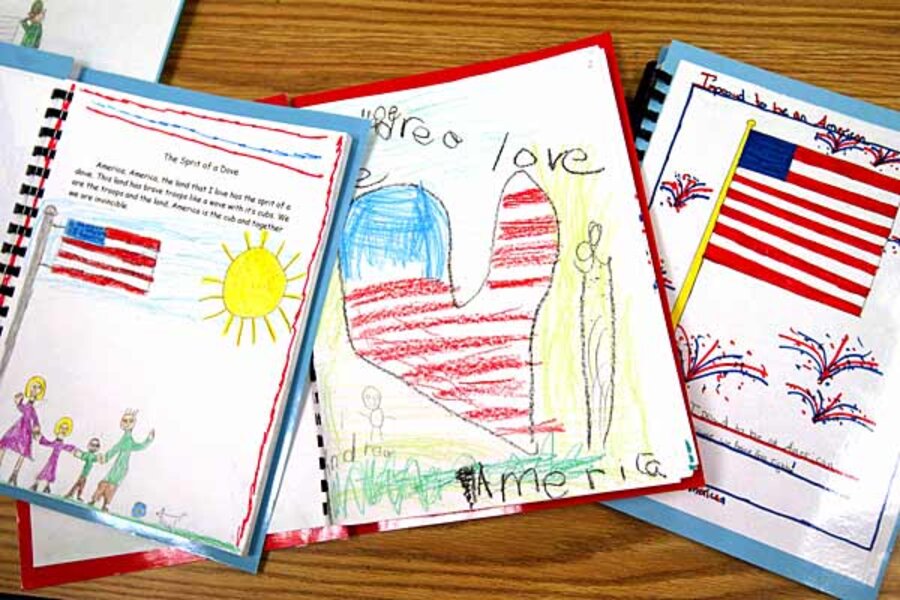September 11 in schools: How teachers are helping students understand
Loading...
Many teachers are putting aside their typical lessons Friday to make the 9/11 anniversary meaningful to their students, whether they remember the attacks directly or hadn’t yet been born.
Daniel Maley is bringing to class a simple artifact: a piece of yellow caution tape he found on the ground in Somerset, Penn., where one of the hijacked planes crashed. The police tape is visible in a film he shows his high school students, so he pauses it right there and brings out the tape, along with photos from his visit to the site a month after the 2001 attacks.
“Students always have keener interest when you bring it to them on a personal level,” says Mr. Maley, who teaches Geopolitical Studies to seniors at Hatboro-Horsham High School near Philadelphia.
IN PICTURES - September 11: Revisiting Ground Zero
WATCH VIDEO: Build a 'mosque' near ground zero?
He starts the discussion by asking what they remember of that day. The main question that still tends to emerge: Why were we attacked? So throughout the term he helps them think critically about the complicated history of terrorism, the difference between Islamic terrorists and the broader Muslim community, and the ways US actions are perceived around the world.
“My goal ultimately would be to make them diplomats, in the sense that they’re going to seek solutions to these issues, as opposed to [the initial response of] ‘Let’s just go bomb ’em,’ ” he says.
For educators wondering how best to make the anniversary a teachable moment, a coalition of 9/11 organizations has created age-appropriate lesson plans in subjects ranging from art to social studies. They’re available online at www.911dayofservice.org. More than 6,500 teachers have downloaded the plans so far.
A high school lesson on the site has students delve into the 9/11 Commission Report. Middle-schoolers focus on the figurative language in Bruce Springsteen’s 2002 songs responding to 9/11. Elementary students read an illustrated poem about St. Paul’s Chapel near ground zero, which became a home base for rescue workers.
In videos on the website, students can hear first-hand accounts from a New York police officer on duty that day and a principal who had to evacuate her school amid the ash cloud.
Embedded in the lessons are ways the students can consider acts of service to turn a tragedy into an opportunity. “Teaching about 9/11 and terrorism can be scary stuff for both teachers and students.... [but] the best way to combat this fear ... is to empower our youth to help them see they can make a difference,” said MaryEllen Salamone, who lost her husband on 9/11 and co-founded the 4 Action Initiative, which helped develop the lessons.
Adele Black, a teacher at Copeland Middle School in Rockaway, New Jersey, who also worked on the lesson plans, used children’s 9/11 art to lead a discussion in her 7th-grade class earlier this week. She has also encouraged them to do something nice for others on Saturday, and as a team they’ll be raising money for a children’s cancer charity.
Capt. Tom Daniel, a retired career Navy man who teaches the Navy JROTC program at W.P. Davidson High School in Mobile, Ala., will share with his students his own experience evacuating from the Pentagon on 9/11. He and his colleagues had seen the news about the New York attacks on television, but when the Pentagon was hit, they thought it was a crash of a VIP helicopter, so many of them left their keys and purses on their desks.
On the anniversary, Captain Daniel says, “the most important lesson is pretty much what we emphasize every day – and that’s being good citizens,” not necessarily by joining the military but by doing their best in whatever profession they choose. “That’s how you pay back society for the privileges that you have as an American citizen.”
The private Rowland Hall school in Salt Lake City is holding an assembly Friday, where English teacher Joel Long’s creative-writing students will present poems they’ve written after studying poetry forged in the aftermath of 9/11, such as Galway Kinnell's "When the Towers Fell."
"Maybe I’m idealistic about what art can do,” Mr. Long says, “but I do think that poetry can contain the germ of what matters.”





